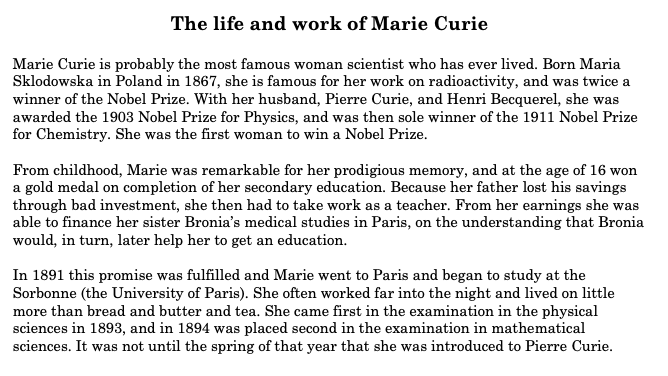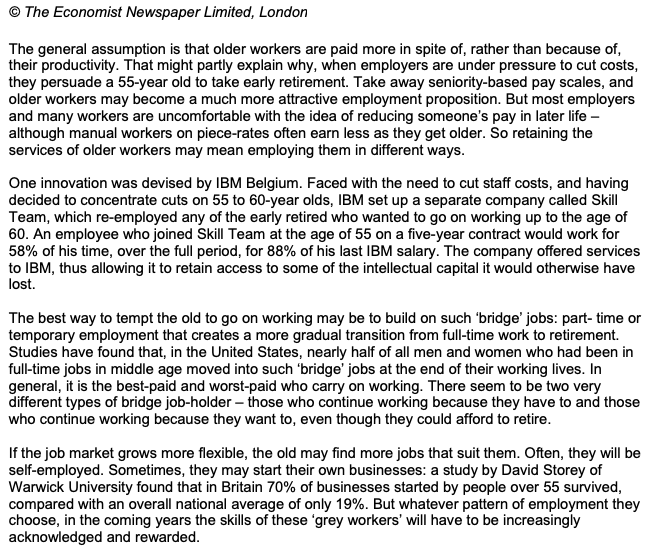FREE ILAC Academic Reading Questions and Answers
Marie Curie’s husband was a joint winner of both Marie’s Nobel Prizes.

Explanation:
"Marie Curie’s husband was a joint winner of both Marie’s Nobel Prizes" is False. While Pierre Curie shared the Nobel Prize in Physics with Marie Curie and Henri Becquerel in 1903, he was not a joint winner of Marie's Nobel Prize in Chemistry in 1911.
Marie became interested in science when she was a child.

Explanation:
The passage does not explicitly state whether Marie became interested in science when she was a child or not.
Marie was able to attend the Sorbonne because of her sister’s financial contribution.

Explanation:
The passage mentions that Marie was able to attend the Sorbonne (the University of Paris) and begin her studies there because of her sister Bronia's financial support. It states, "From her earnings, she was able to finance her sister Bronia’s medical studies in Paris, on the understanding that Bronia would, in turn, later help her to get an education." Therefore, it can be inferred that Marie was able to attend the Sorbonne due to her sister's financial contribution.
The Physics of Traffic Behavior
Some years ago, when several theoretical physicists, principally Dirk Helbing and Boris Kerner of Stuttgart, Germany, began publishing papers on traffic flow in publications normally read by traffic engineers, they were clearly working outside their usual sphere of investigation. They had noticed that if they simulated the movement of vehicles on a highway, using the equations that describe how the molecules of a gas move, some very strange results emerged. Of course, vehicles do not behave exactly like gas molecules: for example, drivers try to avoid collisions by slowing down when they get too near another vehicle, whereas gas molecules have no such concern. However, the physicists modified the equations to take the differences into account, and the overall description of traffic as a flowing gas has proved to be a very good one; the moving-gas model of traffic reproduces many phenomena seen in real-world traffic.
The strangest thing that came out of these equations, however, was the implication that congestion can arise completely spontaneously; no external causes are necessary. Vehicles can be flowing freely along, at a density still well below what the road can handle, and then suddenly gel into a slow-moving ooze. Under the right conditions, a brief and local fluctuation in the speed or the distance between vehicles is all it takes to trigger a system-wide breakdown that persists for hours. In fact, the physicists’ analysis suggested such spontaneous breakdowns in traffic flow probably occur quite frequently on highways.
Reading the passage then choose the correct heading from the list of headings below:
Explanation:
The passage describes how theoretical physicists applied concepts from the study of gas molecules to understand traffic flow behavior.
The Physics of Traffic Behavior
The physicists have challenged proposals to set a maximum capacity for vehicles on highways. They argue that it may not be enough simply to limit the rate at which vehicles are allowed to enter a highway, rather, it may be necessary to time each vehicle’s entry onto a highway precisely to coincide with a temporary drop in the density of vehicles along the road. The aim of doing this would be to smooth out any possible fluctuations in the road conditions that can trigger a change in traffic behavior and result in congestion. They further suggest that preventing breakdowns in the flow of traffic could ultimately require implementing the radical idea that has been suggested from time to time: directly regulating the speed and spacing of individual cars along a highway with central computers and sensors that communicate with each car’s engine and brake controls.
Reading the passage then choose the correct heading from the list of headings below:
Explanation:
The passage discusses a proposal to potentially regulate traffic flow by directly controlling the speed and spacing of individual cars using central computers and sensors. This proposal suggests implementing a system where vehicles' entry onto a highway is timed precisely to coincide with fluctuations in road conditions, aiming to prevent congestion. The idea entails taking control away from individual drivers and relying on centralized control systems to manage traffic flow.
The Physics of Traffic Behavior
However, research into traffic control is generally centered in civil engineering departments and here the theories of the physicists have been greeted with some skepticism. Civil engineers favor a practical approach to problems and believe traffic congestion is the result of poor road construction (two lanes becoming one lane or dangerous curves), which constricts the flow of traffic. Engineers questioned how well the physicists’ theoretical results relate to traffic in the real world. Indeed, some engineering researchers questioned whether elaborate chaos-theory interpretations are needed at all, since at least some of the traffic phenomena the physicists’ theories predicted seemed to be similar to observations that had been appearing in traffic engineering literature under other names for years; observations which had straightforward cause-and-effect explanations.
Reading the passage then choose the correct heading from the list of headings below:
Explanation:
The passage describes the skepticism and disagreement among experts, particularly civil engineers, regarding the application of theoretical physics concepts to traffic control. Civil engineers, who typically focus on practical approaches to traffic problems, question the relevance of the physicists' theories to real-world traffic situations. They argue that traffic congestion is primarily caused by factors such as poor road construction, rather than the complex theories proposed by physicists. This disagreement highlights the differing perspectives and areas of doubt between experts in the field.
The Physics of Traffic Behavior
James Banks, a professor of civil and environmental engineering at San Diego State University in the US, suggested that a sudden slowdown in traffic may have less to do with chaos theory than with driver psychology. As traffic gets heavier and the passing lane gets more crowded, aggressive drivers move to other lanes to try to pass, which also tends to even out the speed between lanes.He also felt that another leveling force is that when a driver in a fast lane brakes a little to maintain a safe distance between vehicles, the shock wave travels back much more rapidly than it would in the other slower lanes, because each following driver has to react more quickly. Consequently, as a road becomes congested, the faster-moving traffic is the first to slow down.
Reading the passage then choose the correct heading from the list of headings below:
Explanation:
The passage discusses how driver psychology and behavior contribute to traffic dynamics. Specifically, it suggests that sudden slowdowns in traffic may be influenced more by driver actions, such as aggressive lane-changing and braking behaviors, rather than complex chaos theory principles. This highlights the significant impact of driver behavior on traffic flow and speed.
Advertisement
Which TWO advantages are mentioned by the writer of the text?

Please select 2 correct answers
Explanation:
The passage highlights two advantages of older workers: their ability to predict areas that may cause trouble in the future and their greater skill in personal relationships. This suggests that older workers possess valuable experience and interpersonal skills that can contribute to effective management and problem-solving in the workplace.
Which TWO disadvantages are mentioned by the writer of the text?

Please select 2 correct answers
Explanation:
The passage discusses two disadvantages of younger workers. Firstly, they may injure themselves due to their lack of experience or caution. Secondly, they are not as well educated as older workers, which suggests that older workers may possess more knowledge or experience in their respective fields.
Skill Team is an example of a company which ________ :

Explanation:
Skill Team, as described in the passage, is a separate company set up by IBM Belgium to re-employ early retired workers between the ages of 55 and 60. The purpose of Skill Team was to allow these older workers to continue working and to retain access to their intellectual capital. Therefore, Skill Team allows the expertise of older workers to be put to use.
According to the writer, ‘bridge’ jobs ________:

Explanation:
The passage mentions that there are two distinct types of bridge job-holders: those who continue working because they have to and those who continue working because they want to, even though they can afford to retire. This suggests that bridge jobs appeal to distinct groups of older workers with different motivations for continuing to work.